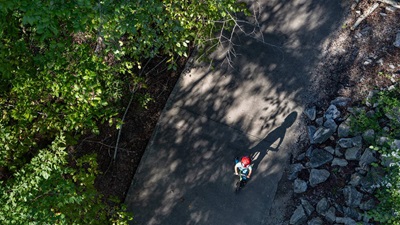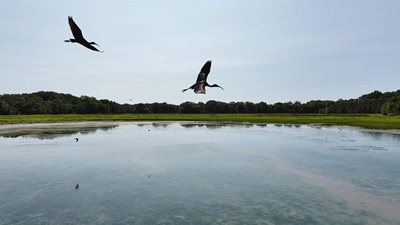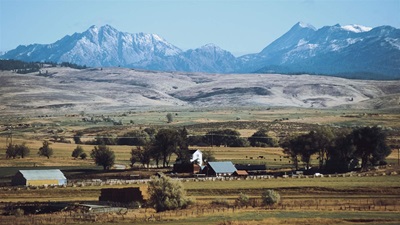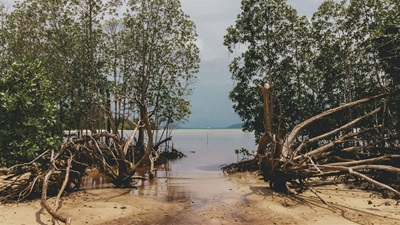From the window of a Cessna, the curving shoreline of a lake dissolves into a maze of channels, each one shuttling liquid gold—water—into the baking heart of the Australian Outback.
I’m on a brief aerial tour with two colleagues from The Pew Charitable Trusts outside the remote cattle-ranching town of Birdsville in southwestern Queensland. We’re here to witness a remarkable phenomenon: the natural, slow-motion flooding of a desert. Birdsville is nearly dead center in the Channel Country, named for the rivers, streams, and countless rivulets that snake through the nearly flat landscape.
“They say you can walk ahead of the flood,” says Traditional Owner Josh Gorringe, of the Mithaka people, referencing the monsoon rains that travel across the Gulf of Carpentaria from November to March. “The gradient here is about 1 centimeter per kilometer, so I believe it.”
Much of that water sets off toward Australia’s interior on a weeks-long journey stretching up to 1,500 kilometers (some 900 miles) and fanning out across the area around Kati Thanda-Lake Eyre. This catchment, the Lake Eyre Basin, is one of the world’s largest internally draining river systems, feeding three major rivers—the Diamantina, Georgina, and Cooper Creek—that spill into the Channel Country, where they then recharge crucial waterholes and wetland habitats.
These floods can vary greatly—massive in some years and paltry in others—but one thing remains constant: this water is invaluable to the ecosystems, wildlife, and people of the Outback. Among its many benefits, the water draws millions of birds, including herons, egrets, kites, and cranes. White pelicans flock here from Australia’s south and east coasts, up to 1,000 kilometers (some 600 miles) away, and the floods sustain wildlife across an area covering one-sixth of the Australian continent.
“In good years, we have the highest concentration of pelicans in the world,” says Gorringe, who is general manager of the Mithaka Aboriginal Corporation, which represents Mithaka cultural, social, and economic interests across the region. The three large rivers are perennial and home to thriving fish populations, which the birds can feast on with little fear of the predators and storms that stalk them along the coasts. “The birdlife here is good for tourism, for the land, and for the balance of everything,” Gorringe says—one reason the Queensland government recently banned any future oil and gas operations here.
The moisture also enables the region’s multibillion-dollar organic cattle industry to thrive.
“This is the most fertile desert in the world,” says David Brook, who started OBE Organic—Australia’s first organic beef exporter—in the 1990s. Brook, whose forebears settled in Channel Country in the 1800s, is the undisputed cattle king of Birdsville, with 40,000 head of cattle roaming over 8 million acres. And he wants this landscape to remain pure.
“I’ve been begging the government for years not to allow cotton or other industries into the Channel Country,” says Brook, a solid man with graying hair.
Chatting in the garden of his ranch house, Brook explains that industrial activity would bring water diversions that would “shorten the Diamantina by at least 100 kilometers (some 60 miles),” with untold environmental consequences, and would likely threaten his production of organic beef, which sells for significantly more per kilogram than nonorganic meat.
Brook does not use fertilizers or pesticides. But he says his efforts to safeguard the landscape could be for naught if cotton producers, new mines, or other industrial operations moved in nearby as pesticides and other chemicals could travel on the wind. “These rivers have myriad channels,” he says. “We’re going see it all going wrong if the government allows development. So much of this area is still pristine, so now is the time to protect it.”
It’s a sentiment that has seen the cattle ranching community linking arms with conservationists and the Indigenous Traditional Owners to oppose any expansion of oil and gas, mining, or large-scale irrigation within the rivers and flood plains of the Lake Eyre Basin.
“There’s nowhere else on Earth like this basin,” says Riley Rocco, who directs Pew’s conservation efforts in the region. “And if the rivers and wetlands are compromised, we could lose one of Australia’s greatest natural assets.”
A cautionary tale from the other side of the planet supports this concern: The Aral Sea, in present-day Kazakhstan and Uzbekistan, was once the fourth-largest body of inland water in the world. In the 1950s, it yielded nearly 50,000 tons of fish per year and was akin to a huge version of Lake Eyre, serving as the terminus for rivers that flowed through thousands of square miles of central Asia. But after decades of Soviet government diversion of the rivers that fed the Aral Sea, it withered into a desiccated wasteland.
Over the past three decades, there have been signs that the Channel Country region could meet a similar fate. In 1996, ranchers, conservationists, and scientists united to reject plans for new cotton development in the Cooper Creek catchment. A public campaign led to the creation of the Wild Rivers Act, which enshrined protections to preserve intact rivers. But a subsequent change in government led to the repeal of these protections and opened the door to extractive industries.
In 2021, the Queensland government granted 11 leases for “unconventional petroleum”—i.e., fracking—across 250,000 hectares (about 600,000 acres) in the Lake Eyre basin, a move that immediately concerned the 17 Aboriginal groups, including the Mithaka, that hold native title rights throughout the basin.
The threat also sparked a unified opposition from conservation groups and cattle ranchers who banded with Indigenous communities to seek a reversal of the government decision.
In December 2023, the Queensland government resolved to ban all new oil and gas operations on the basin’s rivers and flood plains. It also expanded the ban on open cut mining and large-scale irrigation to cover all rivers in the Queensland portion of the Lake Eyre Basin—an additional 5,100 miles.
“This outcome is the best-case outcome in terms of offering strong protections for the rivers and flood plains while allowing development to occur in less sensitive areas of the Lake Eyre Basin,” Rocco says.
Gorringe, who’s spent almost all of his life in Channel Country, including as a stockman, feels the same way. Despite his cowboy look—jeans, flannel shirt, work boots, and a cowboy hat—Gorringe knows this land like his paternal ancestors. Even behind the wheel at 80 miles per hour, he rattles off the names of plants blurring past, swerves to miss foot-long bearded dragon lizards sunning in the road, and spies a kangaroo bounding through distant brush.
Gorringe says ranchers need to make sure they don’t drain nutrients from the soil, which happens when cattle overgraze - and they must also resist the urge to plant non-native grasses as cattle fodder. Buffel grass, for example—imported in the 1870s from Africa and widely used in the following century—depletes the soil of calcium and phosphorus, crowding out native grasses and changing how wildfires affect the landscape.
The Mithaka people hope to restore large areas of land across the Channel Country basin. This would see sustainable cattle operations, re-introduction of native species, and new cultural tourism and ecotourism, including stargazing—a natural fit in a place that boasts some of the least light pollution on Earth. Gorringe says tourism opportunities could include talks from Mithaka and other Indigenous elders to help teach visitors the value of the region and motivate local community members to be better stewards of their own land.
While there are a lot of hard miles between the Outback and the country’s population centers, visitors find this stunning, meditative landscape unique and well worth the journey.
In Birdsville, for example, we met Vicky, who drove 1,400 miles with her dog to escape the cold and rain of Melbourne for a few weeks. “A lot of desert along the way,” she reports. “Tough country, but beautiful. I like the open space.”
And then there are the annual horse races. The significant tourist attraction is the reason the sign at the edge of town reads, “Welcome to Birdsville: Population 115 (+/- 7,000).”
The locals embrace the carnival-like intrusion of the races, including amateur boxing competitions. A pop-up marquee reads “Fred Brophy’s Boxing Tent—The Last Boxing Tent Touring Australia,” and the rolling desert surrounding town is speckled with tents, camper vans, and RVs. But the real allure of this region is the quiet and solitude that prevail the rest of the year.
“The environment is the bread and the basket for this whole area,” Brook says, adding that the land could be viable for ranching for at least the next 2,000 years.
This philosophy is shared by Don Rowlands—a Wangkangurru Yarluyandi elder who thinks in even longer time frames. In Rowlands’ vision for the Channel Country, conservation must start with the people who lived on this land for 60,000 years before Europeans arrived.
Rowlands, age 75, is a senior ranger for Munga-Thirri National Park, which begins on the outskirts of Birdsville and extends for 10,000 square kilometers (3,860 square miles) into the Simpson Desert. Rowlands spent most of his life working the cattle stations around Birdsville before taking the ranger job in 1994.
“What they ought to do is give all this land to the Indigenous people, starting yesterday,” Rowlands says. “If we got the land, we could fence parts of it off, give it four or five years to rest, and then do tours. If we do that, a lot of native animals would come back.”
The ban on future oil and gas projects on the Channel Country’s flood plains has been widely welcomed by local communities, Indigenous people, ranchers, scientists, and the wider Australian public. Ensuring that these unique inland rivers remain free flowing has ecological, economic, and cultural effects that go far beyond the braided channels that give the landscape its iconic name.
Managed properly, the Channel Country—an expanse of nearly endless wonder—can serve the needs of flora, fauna, and people alike for millennia yet to come.
“To an outsider, this all must not look like much,” says Goringe. “But there’s a lot of life here, and if people take care of it the way they should, it can stay that way for a long time.”
John Briley is a Trust staff writer.













